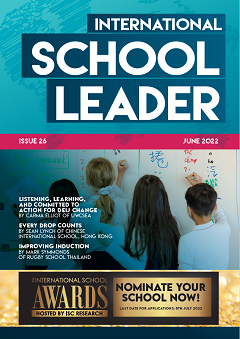By Nik Higgins
Before co-founding The Ambassador Platform, I spent a number of years working in further education in the UK. During this time I was responsible for managing teams that, amongst a predictably eclectic bunch of other stuff, were responsible for delivering careers guidance to students aged 16-19. I spent this early part of my career in comprehensive, inner-city sixth form colleges; admittedly a very different kind of educational setting to a typical international school. However, the two are not without parallels. This is particularly the case in relation to the provision of pathways and progression planning.
A globally challenged strategic priority
Ask any good head and they will tell you that securing successful destinations for their current students is a key strategic priority for their school. Progression to excellent tertiary education and training options says a multitude of great things about the support available to students, and speaks to a positive and holistic approach taken by the school. The thing is, despite the emphasis placed on the ultimate outcomes, the capacity to provide the necessary support to achieve them can often be limited. From London to Pattaya, counsellors responsible for all kinds of pathway planning face the challenge of having limited time in which to deliver detailed guidance to a large number of students. Providing high quality, tailored advice is difficult at the best of times, but is particularly complex when you are a team of one or need to advise about a very broad range of options.
This is an issue that I became acutely aware of during the time I spent managing guidance staff. How on earth was one counsellor supposed to acquire and maintain a deep knowledge of all pathway options? An up-to-date awareness across the basic options is a big ask. Expecting a counsellor to have a deep familiarity with any given option that a student may be considering is something else entirely. The problem is, without that level of familiarity, how can a counsellor advise a student whether that option is the best-fit for them, beyond exercising their broad professional discretion?
Emerging technologies
The answer to that question is (or at least was) that, in reality, they can’t. If one of their students is considering a university that they, the counsellor, are personally unfamiliar with then, beyond relaying basic information and checking compatibility in terms of entrance requirements and qualifications, there isn’t much more that can be done. It’s important to stress here that this issue is in no way the fault of the counsellors themselves. There are a lot of universities in the world (apparently about 30,000!). It’s impossible for anyone, no matter how dedicated, to have a nuanced knowledge of more than a handful of that number.
That’s where the benefits of technology can come in. The Ambassador Platform, for example, is the leader in a new category of technology called Experience Communication Management (XCM). If you’re not familiar with the term, then it’s worth checking out some of the other players in the space. Campus Connect (based in Ireland) and ZeeMee (based in the US) are two other companies doing interesting things. XCM technology allows, in this instance, Higher Ed providers to showcase what it’s really like to live and study at their institution by connecting prospective students (who could be your students!) with ambassadors from across the university or college. The University of Sydney (Australia) and The University of Sheffield (UK) are two examples of universities who have used TAP to great effect.
Distributed guidance
So, you may ask, what has this got to do with pathways planning at my school? A lot, I would say. Particularly if your school operates with a single college counsellor or you’re keen to expand the horizons and destinations of your students. As I’ve argued, it’s something of a mathematical impossibility for any single counsellor to hold a deep and nuanced understanding of more than a few universities. Of course, they can read the admissions materials of any university online – finding a digital prospectus is usually only a couple of clicks away. However, these kinds of resources rarely provide more than a generic view of the institution. Getting to the heart of what it’s ‘really like’ is simply beyond the parameters of most university websites, and certainly beyond the purview of their usual marketing and admissions output.
This is a problem for counsellors. Aside from time limitations, they are also asked to advise whether a particular destination is the best-fit for one of their students based on what is, in reality, incomplete information. The issue of what constitutes best-fit is complex and is inherently unique to every young person. It’s just as much (and arguably more) about whether an institution will suit them socially and emotionally, than it is about whether they have the necessary academic qualifications to be offered a place. The former dynamics are simply not questions that a counsellor, lacking personal experience of a particular university, can be expected to advise on.
Here, XCM technology has the answer. It offers a mechanism for the guidance ‘burden’ to become distributed across a number of people. Inherent in this distribution is also the inclusion of more people, with more perspectives, experiences, and advice. In practice this means that one of your students, if they were considering a university that is using XCM technology, would be able to interact with ambassadors (who could be students, staff, faculty, or alumni) and gain a more personalised insight into whether that institution is the best-fit for them. The counsellor retains their highly important position as an experienced sounding board, but, in this distributed model, there is no necessity for them to understand the granular reality of every given pathway option. They continue to guide, but the student is given agency over the exploration of best-fit and the possible sources of information are increased by orders of magnitude.
Closing the loop
As a final point, it is worth noting that XCM technology isn’t something reserved for universities and colleges. Many international schools are now also implementing such platforms as a way to ensure that prospective parents can access a broad and highly personalised set of insights about their school. The Chat to our Parents page on the Dulwich College Singapore website is a great example of how the concept of distributed guidance can be flipped on its head and used to enhance a schools marketing and admission strategy.
 Nik Higgins is Co-founder and Chief Growth Officer at The Ambassador Platform. Connect directly with Nik on LinkedIn.
Nik Higgins is Co-founder and Chief Growth Officer at The Ambassador Platform. Connect directly with Nik on LinkedIn.
Subscribe to ISL Magazine for more!

